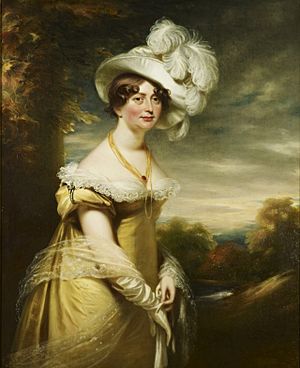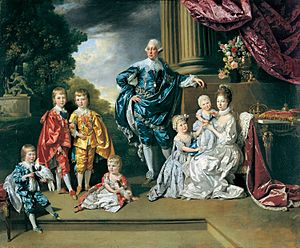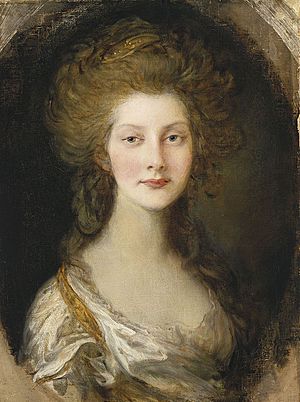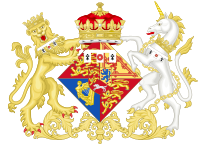Princess Augusta Sophia of the United Kingdom facts for kids
Quick facts for kids Princess Augusta Sophia |
|
|---|---|

Portrait by William Beechey
|
|
| Born | 8 November 1768 Buckingham House, City and Liberty of Westminster, Middlesex, England |
| Died | 22 September 1840 (aged 71) Clarence House, London, England |
| Burial | 2 October 1840 Royal Vault, St George's Chapel, Windsor Castle |
| House | Hanover |
| Father | George III, King of the United Kingdom |
| Mother | Charlotte of Mecklenburg-Strelitz |
Princess Augusta Sophia was a daughter of King George III and Queen Charlotte of Great Britain. She was their sixth child and second daughter. Augusta Sophia was born on November 8, 1768, and passed away on September 22, 1840.
Contents
Growing Up Royal: Princess Augusta's Early Life

Princess Augusta Sophia was born at Buckingham House in London. She was the sixth child and second daughter of King George III and Queen Charlotte. Her father really wanted another girl. He was delighted when Augusta was born, a small and pretty baby.
She was christened on December 6, 1768. The ceremony took place at St James's Palace. Her godparents included her uncle, Prince Charles of Mecklenburg. Her aunts, the Queen-consort of Denmark and the Hereditary Duchess of Brunswick-Lüneburg, were also godparents. A lady named Lady Mary Coke called the baby Augusta "the most beautiful infant I ever saw."
Princess Augusta was the middle child of three older sisters. These were Charlotte (born 1766) and Elizabeth (born 1770). In 1771, Augusta and Charlotte began lessons at Kew Palace. They were taught by Lady Charlotte Finch and Miss Frederica Planta. The princesses, who were once close to their brothers, now saw less of them.
Royal Education and Hobbies
In 1774, Martha Goldsworthy became their new head teacher. The princesses learned many things. They studied deportment, music, dancing, and art. Their mother also made sure they learned English, French, German, and geography. They had very well-educated governesses.
Augusta was a favorite of Miss Planta. She called Augusta "the handsomest of all the Princesses." However, Augusta was very shy. She would stammer when speaking to people she did not know. From a young age, Augusta wanted to be good. She often got upset if she did not succeed.
Sometimes, she would throw tantrums. Other times, she was calm and family-focused. She disliked the arguments between her older brothers and their parents. Instead, she liked to collect coins. Augusta and her sisters were very sheltered. Their only friends were their attendants. They wrote letters to them often.
Public Appearances and Family Life
In 1782, Augusta made her first public appearance. This was at the King's birthday celebrations. Her mother did not tell her about it until two days before. Augusta was still very scared of crowds. Later that year, her youngest brother, Prince Alfred, died. Eight months later, her next youngest brother, Prince Octavius, also died.
In 1783, the princesses visited the Royal Academy of Arts. They saw portraits of their two youngest brothers. They became so sad that they cried in front of everyone. In August 1783, Augusta's youngest sister, Princess Amelia, was born. Augusta was a godmother, along with Charlotte and George. The birth of her sister helped ease the pain of losing her brothers.
By their teenage years, the three oldest princesses spent much time with their parents. They went to the theatre, the Opera, and Court. Their school lessons became less important. Music and art became the main focus. They met famous actresses like Sarah Siddons. Augusta and her sisters also met John Adams, who later became a US President.
The three girls always dressed alike at public events. Only the color of their dresses was different. Augusta was happiest at home. She loved her younger brothers Ernest, Augustus, and Adolphus. She was also very close to her sister Elizabeth. Charlotte was often proud and too aware of her royal position.
Life as a Young Adult Princess
In July 1783, Augusta and Charlotte received their first lady-in-waiting. This meant they were growing up. Augusta often wrote to her older brother William, who was in Hanover for military training. She was a good letter writer. She shared family news and asked about his life. She loved his attention and the small gifts he sent her.
The Queen did not want her daughters to waste time. She made sure the princesses spent hours studying music or art. They learned many special skills from different teachers.
Royal Style and Expenses
The princesses did not "dress up" until dinner. They wore simple morning gowns most of the day. Even when dressed, the Royal family often wore plain clothes. These were very different from the fancy clothes at other royal courts. The Queen had six daughters, so her clothing expenses were huge. She tried to keep costs down.
As the princesses grew older, the Queen spent more money on them. They always needed new dresses, hats, and fans. The cost for their clothes was about £2000 every three months. The cost of their servants and tutors added to this. However, the princesses became well-known to the public. Their group portrait was admired for their beauty. They dressed the same, but their accessories hinted at their different personalities.
Marriage Prospects and Royal Rules
By 1785, Augusta and Charlotte were old enough to marry. The Crown Prince of Denmark wanted to marry a British princess. He was said to prefer Augusta. However, King George III refused. He remembered how his younger sister, Caroline Matilda, was treated in Denmark. He would not send one of his daughters there.
As their friends and ladies of the court married, the princesses wondered when it would be their turn. In 1797, Augusta received a marriage proposal. It was from Prince Frederick Adolf of Sweden. But this proposal was not approved by the Swedish royal family. A British princess was a great prize. But Augusta's father seemed less and less willing to let his daughters marry.
Princess Augusta's Private Life
The daughters of George III were not often allowed to have personal relationships with men of their own rank. So, some of them formed close friendships with gentlemen at court. Princess Augusta Sophia met Brent Spencer, a senior British Army officer, around 1800.
She wrote to her brother, King George IV, in 1812. She said that she and Spencer had a special understanding around 1803. This was when Spencer was stationed in England. In 1805, he became an equerry (an attendant) to the king. The two kept their friendship very private. Augusta asked her brother in 1812 if she could marry Spencer. She promised to keep their relationship discreet.
There is no official record of them marrying. However, at her sister Elizabeth's wedding in 1818, it was said that Augusta was "privately married." Spencer told Augusta when her mother died later that year. When Spencer died in 1828, he was said to be holding a locket with Augusta's picture.
Later Years and Legacy
Princess Augusta supported L. Bertolotto's flea circus. This was a popular entertainment at the time.
In 1828, Augusta told a friend something interesting. She said she was ashamed to be called Princess Augusta. This was because members of the House of Stuart family were still alive. But after Cardinal York died in 1807, she felt like a true princess.
On February 10, 1840, Augusta attended the wedding of her niece, Queen Victoria. Victoria married Prince Albert. Augusta died later that year on September 22. She passed away at Clarence House in London. She was buried in the Royal Vault at St George's Chapel, Windsor Castle on October 2. Her body lay in state at Frogmore before the burial.
Titles and Royal Symbols
Titles and Styles
- 8 November 1768 – 22 September 1840: Her Royal Highness The Princess Augusta Sophia
Arms
As a daughter of the King, Augusta Sophia used the royal coat of arms. Her arms had a special design to show she was a princess. It featured a silver label with three points. The middle point had a red rose, and the outer points were ermine (a fur pattern).
See also
 In Spanish: Augusta Sofía del Reino Unido para niños
In Spanish: Augusta Sofía del Reino Unido para niños



